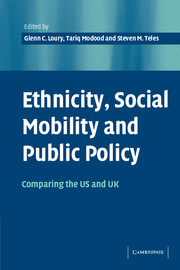Book contents
- Frontmatter
- Contents
- List of figures
- List of tables
- List of contributors
- Acknowledgements
- Introduction
- Part I Historical overviews
- Part II Informal social networks
- Part III Formal structures
- 9 Educational progress for African-Americans and Latinos in the United States from the 1950s to the 1990s: the interaction of ancestry and class
- 10 The educational attainments of ethnic minorities in Britain
- 11 Why America's black–white school achievement gap persists
- 12 Networks and niches: the continuing significance of ethnic connections
- 13 Nonwhite origins, Anglo destinations: immigrants in the USA and Britain
- 14 Social mobility of ethnic minorities
- 15 Ethnic minorities, employment, self-employment, and social mobility in postwar Britain
- Part IV Political institutions and processes
- Part V Normative analysis
- Author index
- Subject index
- References
9 - Educational progress for African-Americans and Latinos in the United States from the 1950s to the 1990s: the interaction of ancestry and class
Published online by Cambridge University Press: 22 September 2009
- Frontmatter
- Contents
- List of figures
- List of tables
- List of contributors
- Acknowledgements
- Introduction
- Part I Historical overviews
- Part II Informal social networks
- Part III Formal structures
- 9 Educational progress for African-Americans and Latinos in the United States from the 1950s to the 1990s: the interaction of ancestry and class
- 10 The educational attainments of ethnic minorities in Britain
- 11 Why America's black–white school achievement gap persists
- 12 Networks and niches: the continuing significance of ethnic connections
- 13 Nonwhite origins, Anglo destinations: immigrants in the USA and Britain
- 14 Social mobility of ethnic minorities
- 15 Ethnic minorities, employment, self-employment, and social mobility in postwar Britain
- Part IV Political institutions and processes
- Part V Normative analysis
- Author index
- Subject index
- References
Summary
Introduction
In the 1950s and 1960s the civil rights movement challenged the legal basis of American-style apartheid. Through civil disobedience, litigation, and legislation, activists and movement organizations riveted the nation's attention on the contradiction between Americans' professed belief in equal treatment and the country's history of racial exclusion. The public confrontation between these contradictions caused millions of Americans to rethink their exclusionary views (Schuman et al. 1998). The net result was that African-Americans' access to public education, voting rights, and public places increased. These changes in white people's outlooks and black people's opportunities raised the expectation in the African-American community – and in other quarters, too – that blacks and whites were on the road to equality.
In the 1990s a countermovement pushed back the resources institutions had been using to increase access for African-Americans and people from other formerly excluded racial and ethnic groups. Under the rubric of “no preferences,” critics of affirmative action have used lawsuits, ballot initiatives, and other means to halt or halter the use of race as a criterion when evaluating candidates for education or employment.
Much of the action in the civil rights movement and in the 1990s backlash has been in schools and universities. Civil rights activists and their opponents focus on education because it is the gateway to opportunity. Educational opportunity has been a resource for the propertyless of all ancestries at least since the nineteenth century.
- Type
- Chapter
- Information
- Ethnicity, Social Mobility, and Public PolicyComparing the USA and UK, pp. 262 - 287Publisher: Cambridge University PressPrint publication year: 2005
References
- 2
- Cited by



